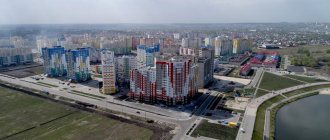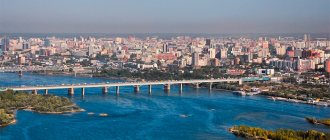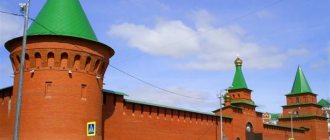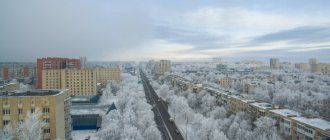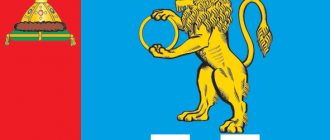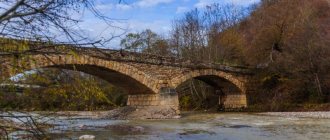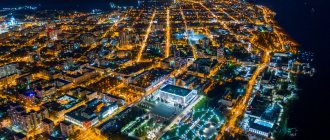Founded: 1586
Samara celebrates City Day on
the 2nd Sunday of September
.
In 2021,
this date is
September 12
.
In 2021, due to the pandemic, mass events in honor of the city day are canceled or may be postponed
In the center of the city there is a monument to Glory
Samara
- Russian city, located on the left bank of the Volga between the mouths of the Samara and Sok rivers.
Samara Town fortress was founded in 1586
, the fortification was built next to the ruins of an older settlement. In 1688, the fortress received city status. Stepan Razin captured the city in 1670, and in 1773 Samara was the first city to side with Emelyan Pugachev.
In 1851, Samara became the center of the Samara province. The province ranks first in the Russian Empire in wheat harvesting.
The area named after
V. Kuibyshev - the largest in Europe In 1935, Samara was renamed Kuibyshev
. During World War II, Kuibyshev became the administrative center of the USSR. The government, diplomatic missions and many evacuated enterprises move here, and the Bolshoi Theater gives performances in the city.
After the war, the city grew rapidly and industry developed. In 1991, the city restored its historical name - Samara.
By Decree of the President of the Russian Federation dated July 2, 2021, Samara was awarded the honorary title of Russian Federation for the significant contribution of city residents to achieving Victory in the Great Patriotic War of 1941–1945, ensuring uninterrupted production of military and civilian products at industrial enterprises, and for the massive labor heroism and dedication shown. Federation " City of Labor Valor"
».
Attractions
In Samara there is the largest square in Europe named after V. Kuibyshev, “Stalin’s bunker”. Commemorative complex of the Soyuz launch vehicle, which are produced in the city; Catholic Temple of the Sacred Heart of Jesus, Samara State Drama Theater named after. Gorky.
Samara State Drama Theater named after. Gorky
Not far from Samara, the Volga forms a large bend - the Samara Luka, in which there are the Zhiguli Mountains, which drop steeply towards the Volga, forming unforgettable views.
In honor of the city
one of the asteroids is named Samara 26922. Legends about the underground of Samara are popular due to the construction of large-scale structures such as Stalin's Bunker, Beria's Bunker and the former Army Headquarters bunker.
The city has a population of more than 1,144 thousand people (2020).
Day of the city
in Samara it is celebrated in September.
Blog "Apartments"
The scientific, industrial and cultural center in the Middle Volga region was founded in 1586 at the junction of trade routes from Asia to Europe. The Volga River, Rocket and Space, Soviet attack aircraft Il-2, Zhigulevskoe beer, the folk song “Samara-town” are local symbols that are known throughout Russia.
The symbol of Samara is a goat in the Strukovsky Garden above the grotto. Samara © Glazkov Vladimir / Photobank Lori
Walking excursion route
Despite the impressive area of the city, getting around Samara is easy. The bustling life of the metropolis is in full swing near the Volga, so traffic goes either “to the river” or “from the river”.
Samara embankment
A popular vacation spot for citizens and guests of Samara and the starting point of excursion routes is the 5-kilometer Embankment, which descends in terraces to the river.
Until the middle of the 19th century, this territory was chaotically built up with barns and timber exchanges. Its arrangement began in 1935. As a result of the work, granite retaining walls, landscaped beaches, and cascades of stairs appeared. The modern reconstruction of this territory has made it possible to unambiguously answer the question “what is Samara famous for?” The city is famous for its Embankment.
A lot of greenery, flower beds, benches and tiled walkways create a resort atmosphere in this part of the city.
In the warm season, the Volga sandy beach becomes a focal point for vacationers, to which special descents are equipped from the Embankment. There are observation platforms on the embankment that allow you to admire the waters of the Volga.
In the historical part of the Embankment there are many attractions of Samara. There is a monument to the founder of the city, Prince Grigory Zasekin.
Nearby is the most “Samara” architectural object in spirit - the “Rook” memorial sign. It was erected in honor of the 400th anniversary of the city.
The “Sail” fountain, located on the Leningradsky Descent of the Embankment, has become the symbol of Samara. Its structure is formed by 620 water jets - according to the number of cabin boys who died in wartime.
The originality of small architectural forms is what Samara is famous for. Among the interesting objects, one should highlight the bronze figure of Comrade Sukhov, installed between Leningradsky and Nekrasovsky descent.
In the area of the 6th berth of the River Station there is the Alekseevskaya Chapel, to the right of it there is a monument to the Patron of Samara, Metropolitan Alexy, and to the left is the figure of Sergius of Radonezh. The building was erected in the Russian eclectic style on the site of a religious building that was destroyed in 1930.
Strukovsky Garden
Strukovsky Garden, founded in 1851, is also part of the Volga Embankment.
Samara Academic Drama Theater named after M. Gorky
Adjacent to the Strukovsky Garden is one of the oldest Russian provincial theaters - the dramatic one. It traces its history back to the enterprise of E. Strelkov, created in 1851. The theater's repertoire is constantly updated; it includes classical and modern works.
Samara Academic Drama Theater named after. M. Gorky © FotograFF / Photobank Lori
Monument to Chapaev
This monumental composition by I. Langbard and M. Manizer was installed directly opposite the drama theater in 1932.
Historical development of Kuibysheva Street
On Kuybyshev Street, many buildings from the 19th and early 20th centuries have been preserved. Among the most interesting objects is the Samara Art Museum, founded in 1897.
Its permanent exhibition includes over 1000 works of Russian and foreign painting of the 16th-20th centuries, Russian and European ceramics, and decorative art of the Eastern countries.
The building of the Samara Regional Court (before the revolution - the district court), built in 1870 according to the design of the architect Zasukhin, is known for the fact that V. Lenin worked there as an assistant sworn attorney.
In 1865, the Lutheran Church of St. George was erected on Kuibyshev Street in the neo-Gothic style. The church is currently operational and regularly hosts organ concerts.
One of the key attractions of the city is the mansion of engineer Klodt, built in 1898. Nowadays, a children’s art gallery is opened in the building, designed in a deliberate “gingerbread” style.
The house of the Samara leader of the nobility A.N. Naumov, located opposite the Strukovsky Garden, stands out with its strict lines in the neo-Renaissance style.
In 1911, a public meeting building was erected in Art Nouveau style. Today it hosts an exposition of the Museum of the History of Military District Troops.
Historical development of Leningradskaya/Frunze streets
On most of Leningradskaya Street, the historical appearance of buildings has now been recreated and a pedestrian zone has been formed. The street is a concentration of entertainment venues and retail outlets.
Among the most famous objects of this historical quarter, the building of the old synagogue stands out. It was built in 1908 and was one of the ten most beautiful synagogues in the world. Now the building is in a state of disrepair.
The Polish church was built in 1906 in the neo-Gothic style. Today this 47-meter building is one of the architectural dominants of the city. The temple is operational, open for individual tours and is often used for music concerts.
The mansion of merchant Sandra Kurlina was built in 1903. The decoration of its façade is a portrait bas-relief of the mistress of the house. Currently, this building houses a branch of the local history museum.
The Samara Philharmonic opened its doors to visitors in 1988. Each of its events becomes a great cultural event.
On Frunze Street we recommend visiting the Chelyshov apartment building, A. Savelyev’s mansion, and the half-timbered house. There are also museums here: the revolutionary Frunze, the city of Samara and the Stalin museum-bunker. This facility, declassified in 1990, was erected during the war as a reserve location for the headquarters of the Supreme Commander-in-Chief. The bunker is a 37-meter shaft.
Today it houses a museum exhibition. Read more about Stalin's bunker.
Iversky Convent
An active Orthodox convent. The tragic history of the monastery began in 1850. After the establishment of Soviet power, the monastery existed for some time under the guise of a sewing artel, and in 1925 the monastery was closed. In the early 1930s, the monastery Assumption Church, the second largest temple in Samara, was blown up. Only in 1992 did the revival of the monastery begin. The temples, belfry and cell buildings built in neo-Byzantine style are located in cascades on the Volga slope. This gives the city panorama expressiveness and picturesqueness.
Zhigulevsky brewery
On the Embankment, not far from the Iversky Monastery, you can see the red brick buildings of the brewery. The plant was founded in 1881 by Austrian citizen Alfred von Vacano. The main recommendation of city residents is to take a tour of the territory of this plant. Next to the working buildings there is a branded beer restaurant, as well as the iconic bar “At the bottom”. Only the best unfiltered varieties of brewing products are offered here.
The Von Vacano factory, the birthplace of Zhigulevsky beer. Russia, Samara © Vadim Orlov / Photobank Lori
Samara Regional Museum of History and Local Lore named after P.V. Alabina
The museum was founded in 1880 and has been actively developing since then. The museum's collection contains over 200 thousand exhibits. The museum has extensive collections of rare books from the 18th–20th centuries and weapons from the 14th–20th centuries.
The figure of St. Nicholas the Wonderworker near the house in which “Zoya’s standing” took place
House No. 84 on Chkalov Street receives many excursions and pilgrimage visits. Here, according to church traditions, in 1956 an event took place known as the “standing of Zoya.” A girl who decided to dance with the icon of St. Nicholas the Pleasant on New Year's Eve was literally petrified. She stood, clutching the icon in her hands, without food or drink, for 128 days. Currently, a figure of St. Nicholas the Wonderworker is installed next to the house.
Wooden buildings on Buyanova Street
After visiting the house where “Zoya’s standing” took place, be sure to visit the neighboring Buyanova Street, where ancient Samara wooden buildings have been preserved.
Monument rocket "Space Samara"
In 2001, the Soyuz rocket, manufactured by the Kuibyshev enterprise Progress and serving as a simulator at the Plesetsk cosmodrome, was installed at the launch position on Lenin Avenue in Samara. At its foot there is a museum exhibition.
River walk
You can take a walk along the Volga from the River Station, located on the Embankment.
This is one of the best ways to get to know Samara, since the city panorama is most impressive from the river area.
Samara onion
In the bend of the Volga, called the Samara Luka, a national park was formed. The bizarre relief, unique features of fauna and flora have earned it worldwide fame. You can explore Luka during a river walk, which should take the whole day.
What to bring from Samara?
A good gift from Samara would be beer produced by one of the oldest breweries in Russia. This gift goes well with an original beer mug.
An excellent addition to the signature beer will be a Volga souvenir - smoked and dried river fish.
Historical reference
The founding date of the city is considered to be 1586 , although a certain pier with a settlement was noted in these places by the Venetians back in 1367. The first fortress was built by Prince Grigory Zasekin, according to the version for the Nogais who lived here to protect them from “dashing people”, but in fact , of course, to ensure the safety of trade routes between Kazan and Astrakhan.
The inhabitants of the fortress were initially “service people” who performed a security function. At the turn of the 17th – 18th centuries, as a result of fires, the fortress ceased to exist, and only in the anniversary year of 1986 a frame was made as an imitation of one of the towers, and a wall element with a memorial plaque.
From its very foundation, Samara was considered a city, in the 17th century. it was the center of the county, and at the end of the 19th century. - Samara province.
These places were not spared by peasant unrest in the 17th and 18th centuries. In 1670, Samara was captured by the soldiers of Stepan Razin, but when Emelyan Pugachev’s uprising began in 1773, Samara became the first city to go over to his side.
From 1929 to 1991 the city bore the name Kuibyshev . During the Great Patriotic War, it was here that the USSR government, a number of the most important departments and, of course, defense enterprises were evacuated. Stalin's move was expected, for which a special bunker was built.
Kuibyshev’s contribution to the victory over fascism is calculated in tens of thousands of aircraft built here, and a huge amount of weapons and ammunition produced at the city’s enterprises.
Project on the theme “My hometown is Samara” for 2nd grade
Goal of the project: As part of studying the subject “The World Around You,” talk about your hometown, its attractions and memorable places.
Find information about his story and share it with your classmates. Tell schoolchildren about Samara and why I love her. Prepare a report and presentation in the form of a photo story. Project plan:
- Location on the country map.
- History and symbols.
- Samara in the present.
- Attractions.
- Places of military glory.
- Conclusion.
- An example of a finished photo story-presentation.
Fell asleep in Kuibyshev, woke up in Samara
And yet, deep down in his soul, Titov himself was not an opponent of innovation. During his student years, he often went to sports competitions in other cities and there he heard that everyone called our fellow countrymen Samarans. The decisive role, according to Titov, was played by the support of the Kuibyshev Regional Executive Committee, which was headed by Viktor Tarkhov. In the end, it was possible to achieve that both the city and the region were renamed at the same time. The residents of Yekaterinburg, for example, did not succeed. According to the first deputy head of Samara, Vladimir Vasilenko, it was at that moment that he was on a business trip in the capital of the Urals. I arrived in Sverdlovsk, and was already leaving Yekaterinburg. At that time, Vladimir Vasilenko was a deputy of the Kuibyshev City Council. According to him, residents of the regional capital split into two camps, between which there was a serious struggle. And although two-thirds of people in everyday life called themselves Samara residents, many understood that old Samara could not have achieved such a level of development if it had not become a reserve capital in Soviet times under Kuibyshev. The discussion in the City Council was very heated, as it included many representatives of industry, the aviation and space industries. And yet, out of 214 people, 114 deputies voted “for”. Vasilenko believes that this can be called a victory for true democracy. And subsequently, not a single one of his voters, who fell asleep in Kuibyshev and woke up in Samara, reproached him for supporting the initiative of local historians.
